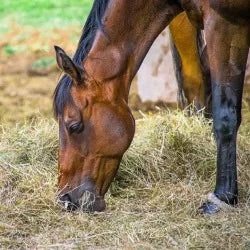We all know what it means to “dangle a carrot”. It means to tease or tempt someone into doing something they might not necessarily want to do, so yes, that is a bribe! When it comes to horses, a little food bribe can go a long way.
But have you considered how your horse’s tasty treat could be the key that unlocks greater range of motion (ROM)? ‘Carrot stretches’ can improve ROM and suppleness through the neck and back by stretching tight muscles. Not only is this beneficial in itself, but this can also help reduce the risk of injury.
There are a few simple exercises that can be done from the comfort of the stable which can significantly improve balance as well as sense of self-movement and body position. These stretches can also be used for the rehabilitation of musculoskeletal injuries when directed by a veterinarian. Pretty powerful stuff, right!?
So, why are carrot stretches so good for your horse? The answer is that these stretches can target muscles involved in the stabilization of the cervical vertebra, parts of the trapezius muscle, and depending on the range of motion the horse has, it can activate the abdominal and back muscles as the barrel bends. All of these are helpful when riding because they allow the horse to become more supple and more comfortable (therefore more willing) under saddle. Improving your horse’s sense of self-movement is beneficial in so many ways, including more awareness over fences, improving hoof-eye coordination and development in flatwork exercise performance.
Similar to when we stretch, equine stretches should be done when muscles are warm, so after exercise is better than before. If you are unable to exercise your horse a five- to ten-minute hand walk should warm muscles up enough to complete these exercises without risking injury.
If you and your horse are new to carrot stretches, we recommend that you perform each stretch 1-2 times, just holding for 5 or so seconds if possible. As the horse’s ROM improves and he becomes more accustomed to the exercises, the number and duration of stretch holds can increase gradually. You will be able to tell when the horse is getting tired if you start to notice that poll tip, rather than the head staying vertical, and this is a good indication that you should stop and do the exercises again next time.



